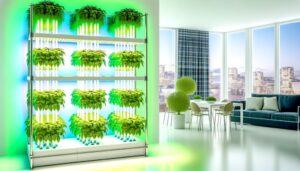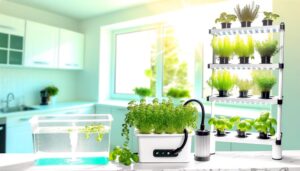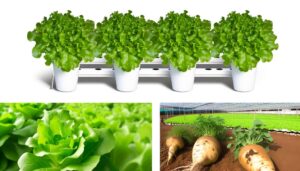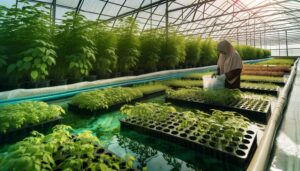What Is a Hydroponic Cucumber
Hydroponic cucumbers are grown without soil, using nutrient-rich water solutions. These systems accelerate growth rates by up to 30%, optimize water usage—reducing it by up to 90%, and guarantee high nutrient uptake efficiency.
We also see a significant reduction in soil-borne diseases, cutting pesticide use by up to 70%. Ideal growth conditions involve a pH of 5.5 to 6.5, with nutrient levels closely monitored.
Common systems include Nutrient Film Technique and Deep Water Culture, which further enhance efficiency. Commercial operations use automated systems for real-time optimization, whereas home setups benefit from the sustainability and fast growth of hydroponics.
Connect with us to learn more fascinating details.

Key Takeaways
- Hydroponic cucumbers are grown without soil, using nutrient-rich water solutions.
- They exhibit up to 30% faster growth rates compared to soil-grown cucumbers.
- Hydroponic systems optimize water usage, reducing consumption by up to 90%.
- Nutrient solutions ensure higher nutrient uptake and better-quality produce.
Definition of Hydroponic Cucumber
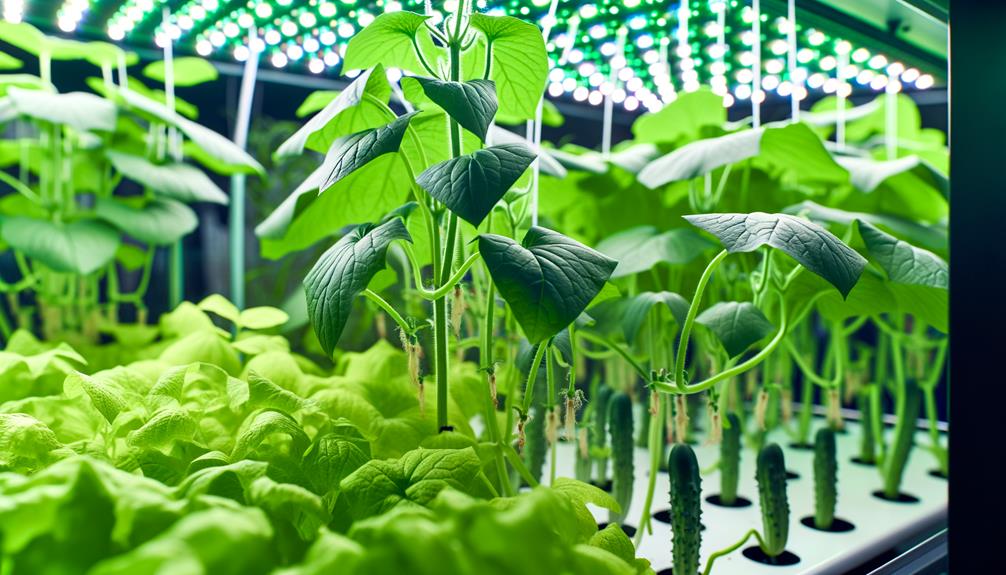
Hydroponic cucumbers, cultivated without soil, utilize nutrient-rich water solutions for ideal growth and yield.
By leveraging hydroponic systems, we can precisely control nutrient delivery, pH levels, and environmental conditions.
Studies show these methods accelerate growth rates by up to 25% compared to conventional soil-based cultivation.
Additionally, hydroponic cucumbers exhibit higher nutrient uptake efficiency, resulting in consistently high-quality produce.
We can optimize water usage, reducing consumption by up to 90%, making this method highly sustainable.
Disease management also improves, with reduced exposure to soil-borne pathogens.
Consequently, hydroponic systems not only promise increased productivity but also align with our goals for sustainable and innovative agricultural practices.
This method redefines how we approach cucumber cultivation for modern needs.
Traditional Vs. Hydroponic Methods
Comparing traditional soil-based cultivation to hydroponic methods reveals significant differences in efficiency, yield, and sustainability.
Hydroponics allows us to grow cucumbers with up to 90% less water usage compared to soil-based methods (University of Arizona study).
We can achieve faster growth rates, leading to a 20-30% increase in yield per square meter.
Additionally, hydroponic systems eliminate soil-borne diseases, reducing pesticide use by up to 70%.
This method also maximizes space utilization; vertical farming techniques enable us to grow in urban settings, cutting down transportation emissions.
The data clearly shows that hydroponics offers a more sustainable and productive approach to cucumber cultivation, aligning perfectly with our need for innovative, eco-friendly agricultural solutions.
Nutrient Solutions
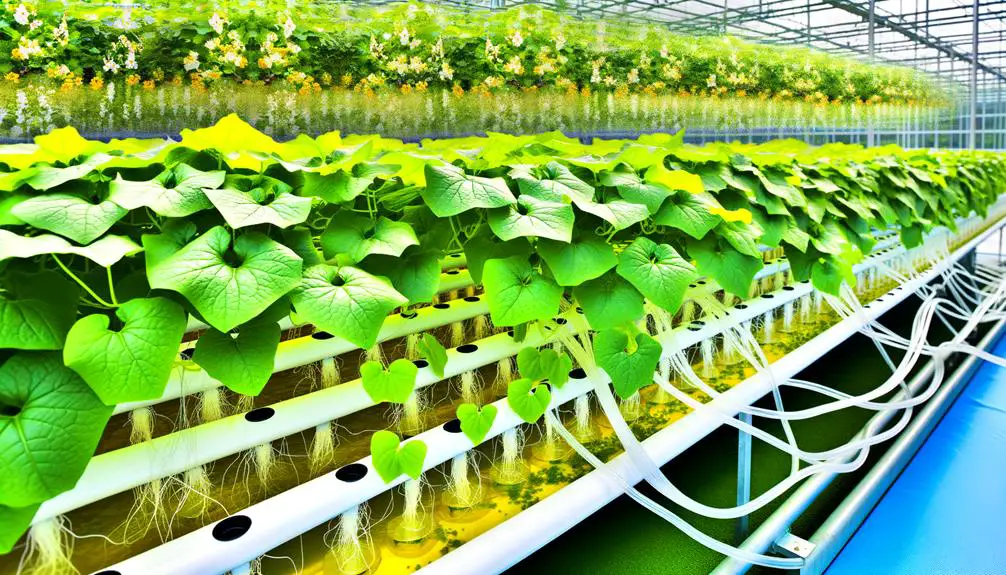
Let's focus on the critical elements of nutrient solutions in hydroponic cucumber cultivation.
We need to evaluate essential nutrient components, maintain an ideal solution pH balance of 5.5 to 6.5, and use efficient nutrient delivery systems.
Research shows that precise control of these factors can result in up to 50% higher yield compared to traditional soil methods.
Essential Nutrient Components
In hydroponic cucumber cultivation, the formulation of nutrient solutions is critical, requiring balanced concentrations of macronutrients like nitrogen, phosphorus, and potassium, alongside essential micronutrients. We need to verify these nutrients are available in precise amounts to optimize growth and yield.
| Macronutrient | Recommended Concentration (ppm) | Role |
|---|---|---|
| Nitrogen (N) | 150-250 | Leaf and stem growth |
| Phosphorus (P) | 50-100 | Root development and fruiting |
| Potassium (K) | 200-300 | Overall plant health and disease resistance |
Additionally, micronutrients such as calcium, magnesium, and iron must be present but in smaller quantities. By adhering to these nutrient guidelines, we can maximize the efficiency of our hydroponic systems, verifying robust cucumber production.
Solution Ph Balance
Maintaining the correct pH balance in nutrient solutions is fundamental to ensuring ideal nutrient uptake and robust growth in hydroponic cucumber systems.
We target a pH range of 5.5 to 6.5, as this range enhances the absorption of essential nutrients like nitrogen, potassium, and magnesium.
Research indicates that deviations outside this range can lead to nutrient lockout, stunting growth and reducing yield.
Regular monitoring and adjustments using pH meters and buffering agents are critical.
We've found that automated pH controllers offer precision, reducing human error and maintaining consistent conditions.
Nutrient Delivery Systems
Effective nutrient delivery systems are the backbone of successful hydroponic cucumber cultivation, ensuring plants receive the precise balance of nutrients needed for peak growth. We need a robust system to deliver essential macronutrients and micronutrients efficiently. Research indicates that the ideal nutrient solution should have a pH between 5.5 and 6.5, with an electrical conductivity (EC) of 1.8–2.4 mS/cm.
| Nutrient | Ideal Concentration (ppm) | Function |
|---|---|---|
| Nitrogen (N) | 140-160 | Promotes leaf and stem growth |
| Phosphorus (P) | 40-60 | Crucial for root development |
| Potassium (K) | 200-250 | Enhances fruit quality |
| Calcium (Ca) | 150-200 | Strengthens cell walls |
| Magnesium (Mg) | 40-60 | Essential for photosynthesis |
Types of Hydroponic Systems
When exploring hydroponic systems for cultivating cucumbers, we find that the three most effective methods are Nutrient Film Technique (NFT), Deep Water Culture (DWC), and Drip Systems.
NFT involves a thin film of nutrient solution flowing over the roots, optimizing nutrient uptake. According to research, NFT systems can increase cucumber yield by up to 30%.
DWC submerges roots in an oxygenated nutrient solution, promoting rapid growth; studies show it can result in a 20% faster growth rate.
Drip Systems deliver nutrient solution directly to the root zone, minimizing water waste and ensuring precise nutrient delivery. Data indicates that drip systems can reduce water usage by up to 50% compared to traditional soil methods.
Growing Conditions
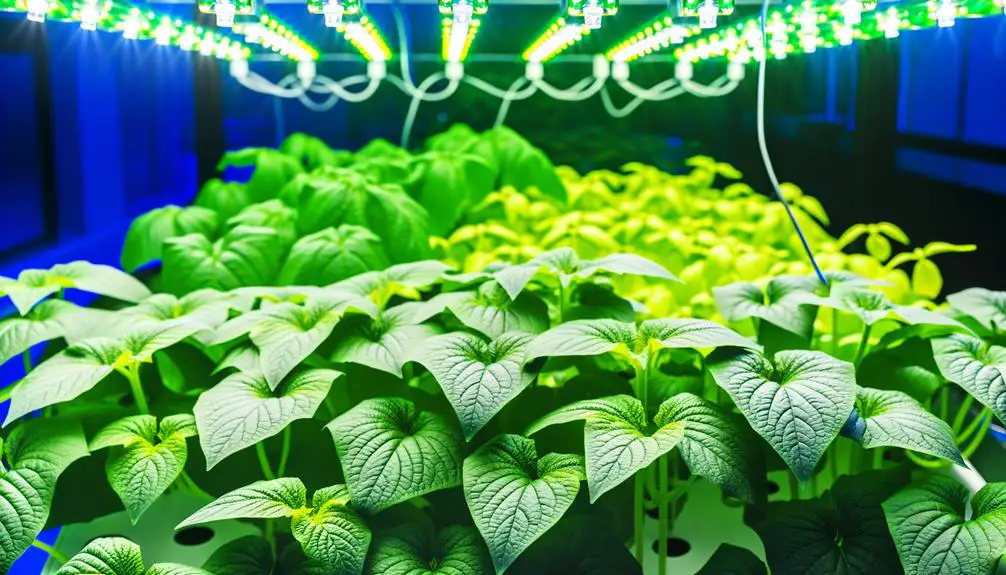
Let's examine the critical growing conditions for hydroponic cucumbers, focusing on ideal light requirements, nutrient solution balance, and temperature and humidity control.
Research indicates that cucumbers thrive under 14-16 hours of supplemental light daily, with a nutrient solution pH of 5.5-6.0.
Maintaining a temperature range of 70-75°F and humidity levels of 60-70% guarantees maximum growth and productivity.
Ideal Light Requirements
Ideal growth of hydroponic cucumbers requires at least 12-14 hours of full-spectrum light daily to confirm proper photosynthesis and plant development.
We should prioritize using LED grow lights, which offer energy efficiency and customizable light spectrums. Research shows that blue light (450-495 nm) promotes vegetative growth, while red light (620-750 nm) enhances flowering and fruiting.
Moreover, maintaining a light intensity of 400-600 µmol/m²/s is essential for peak growth. By employing timers, we can automate light schedules to guarantee consistency.
Data indicates that consistent light exposure not only accelerates growth but also improves yield quality. Let's not overlook the importance of periodic light measurement with a PAR meter to adjust intensity and spectrum, confirming our cucumbers receive the best possible light conditions.
Nutrient Solution Balance
Maintaining the correct nutrient solution balance is crucial for the ideal growth and yield of hydroponic cucumbers. Our approach focuses on accurate nutrient ratios, fundamental for maximizing plant health and productivity. Research indicates that cucumbers thrive with a nutrient solution containing a balanced mix of nitrogen, phosphorus, and potassium, along with trace elements like magnesium and calcium.
Key considerations include:
- pH Levels: Maintain a pH range between 5.8 and 6.2 for optimal nutrient absorption.
- Electrical Conductivity (EC): Target an EC of 1.8 to 2.4 mS/cm to guarantee adequate nutrient concentration.
Temperature and Humidity
Consistently regulating temperature and humidity is essential for achieving ideal growth conditions in hydroponic cucumber cultivation. Research indicates that cucumbers thrive best at temperatures between 70-75°F during the day and 65-70°F at night. Deviations can stress plants, reducing yield.
Humidity levels should be maintained between 60-70% to enhance transpiration and nutrient uptake. High humidity above 80% risks fungal growth, while low humidity below 50% can cause wilting.
Using sensors and automated climate control systems, we can precisely monitor and adjust these parameters. Innovative climate control technologies guarantee consistent conditions, thereby maximizing growth efficiency and produce quality.
Let's leverage data-driven approaches to achieve superior growth environments for hydroponic cucumbers, ensuring robust, high-yield harvests.
Benefits of Hydroponic Cucumbers
Hydroponic cucumbers offer several benefits, including faster growth rates and higher yields compared to traditional soil cultivation. By utilizing nutrient-rich water solutions, we can optimize plant health and maximize production efficiency. Additionally, hydroponic systems reduce the risk of soil-borne diseases, guaranteeing healthier crops.
Advantages of hydroponic cucumbers include:
- Increased Efficiency: Studies show hydroponic cucumbers grow up to 30% faster than soil-grown counterparts, translating to quicker harvest cycles.
- Resource Conservation: Hydroponic systems use approximately 90% less water, making them a highly sustainable choice.
Common Challenges
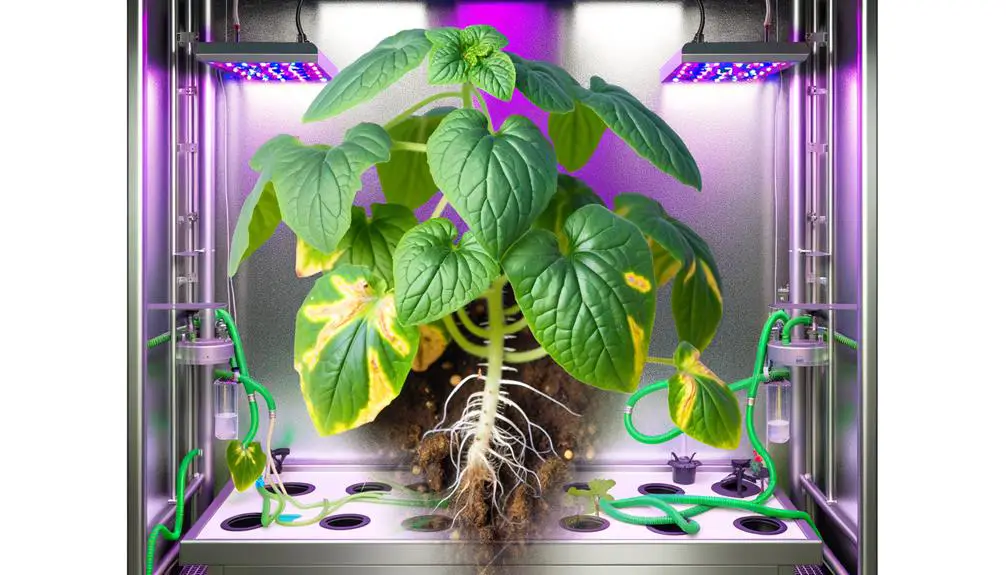
While hydroponic cucumbers boast numerous advantages, we must also address the common challenges that can arise in these systems. Nutrient imbalances and pH fluctuations can severely impact plant health. Additionally, maintaining ideal temperature and humidity levels is vital but often difficult.
| Challenge | Impact |
|---|---|
| Nutrient Imbalance | Stunted growth, poor fruit quality |
| pH Fluctuations | Nutrient lockout, root damage |
| Environmental Control | Increased pests, disease occurrence |
Proper monitoring and adjustment of nutrient solutions are essential to mitigate these issues. Data shows that even slight deviations in pH can lead to nutrient lockout, affecting cucumber yield. Furthermore, integrated pest management (IPM) techniques are imperative to control pest and disease outbreaks in a controlled environment. By addressing these challenges, we can enhance our hydroponic cucumber production.
Commercial Hydroponic Farming
Commercial hydroponic farming leverages advanced technology and precise nutrient management to maximize cucumber yields and quality. By enhancing environmental control systems, we guarantee that each cucumber plant receives the ideal balance of light, temperature, and humidity. This method not only enhances growth rates but also improves crop consistency and resilience.
Key components include:
- Automated Nutrient Delivery Systems: These systems provide exact nutrient formulations, tailored to each growth stage of the cucumber plants.
- Climate Control Technologies: Sophisticated sensors and control units maintain superior growing conditions, reducing the risk of pests and diseases.
Home Hydroponic Gardening
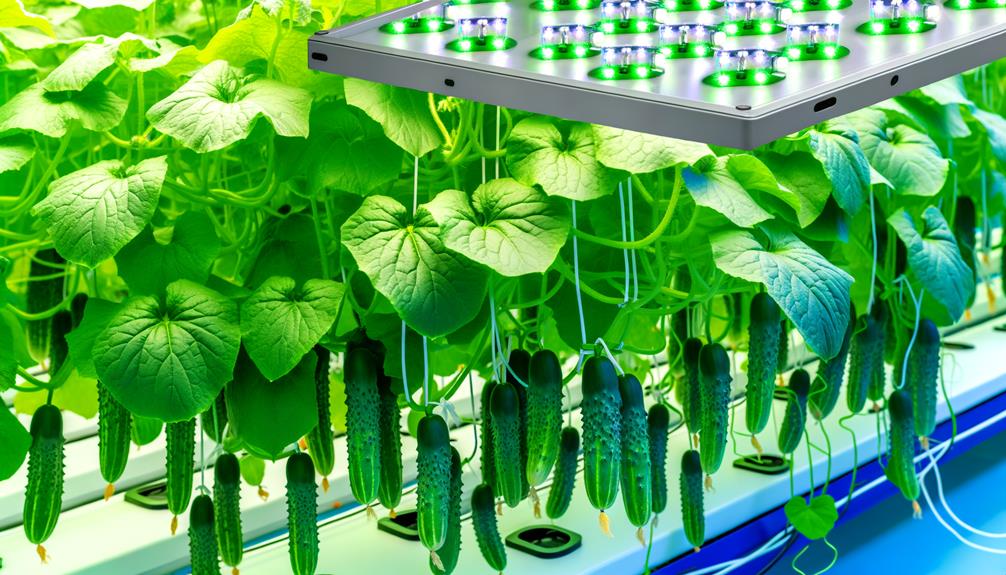
Expanding from large-scale operations, home hydroponic gardening allows individuals to cultivate cucumbers with the same precision and technological advantages, albeit on a smaller scale.
By employing systems like Nutrient Film Technique (NFT) or Deep Water Culture (DWC), we can control nutrient delivery, pH levels, and light exposure. This results in a 20-30% faster growth rate compared to traditional soil methods.
Data indicates that hydroponically grown cucumbers have higher yields and fewer pest issues. Using LED grow lights and automated nutrient dispensers, we optimize energy consumption and resource use.
This approach not only maximizes space efficiency but also reduces water usage by up to 90%, making it a sustainable option for urban dwellers and innovation enthusiasts alike.
Conclusion
To summarize, hydroponic cucumbers offer a sustainable alternative to traditional farming.
We witness a serendipitous alignment of factors: precise nutrient control, optimized growth conditions, and reduced environmental impact.
Data shows that hydroponic methods can yield up to 20% more produce while using 90% less water.
As we embrace these methods, we're not just adapting; we're paving the way for a future where agriculture is both efficient and eco-friendly.
Let's seize this opportunity to revolutionize our food systems.

